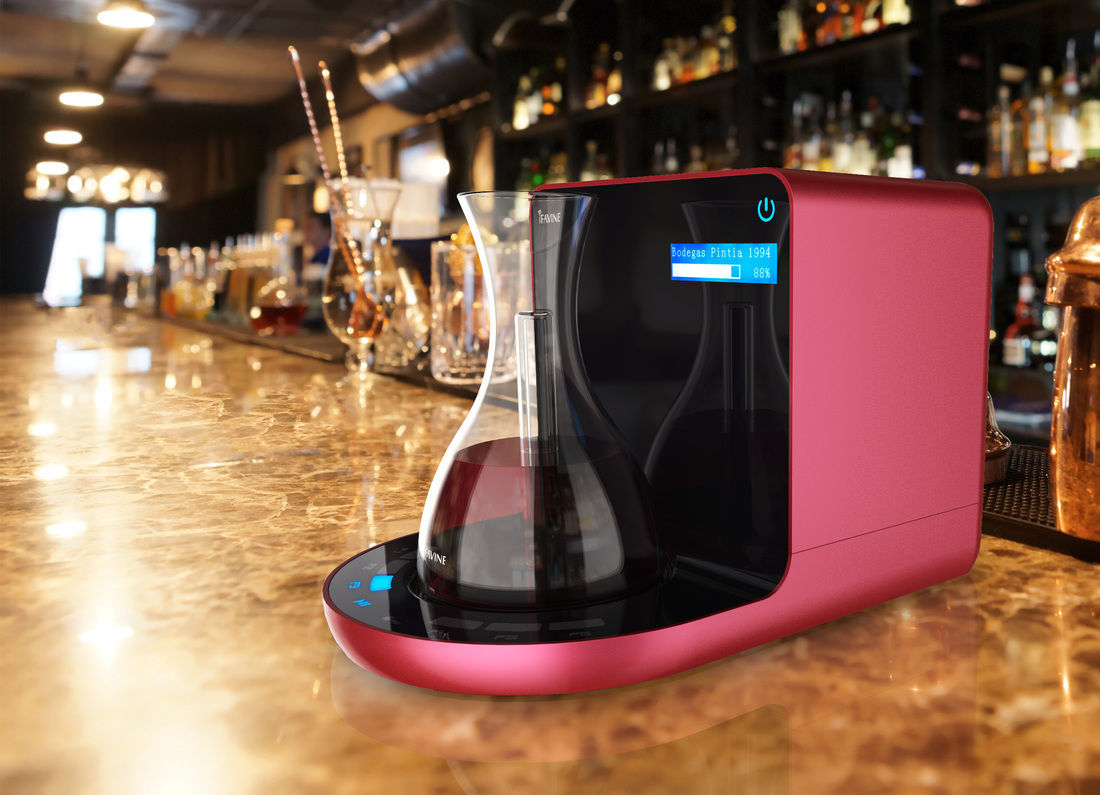n
Minutes later (hopefully), the server arrives with the bottle, opens it without injury or international incident, and pours you a taste. You swirl, sniff, take a sip, and–hopefully out of the sight of your dining compadres – grimace because the wine is tight, tannic, and astringent—far from pleasant. The server then goes on to pour for the rest of the table. Your dining buddies are completely oblivious to the fact that the young Cabernet you’ve chosen is so tannic it could probably take oil stains off a driveway. They chatter away and happily drink glass after glass for all the world like it’s Nouveau Beaujolais. Fortunately, a bit of time and resulting oxidation help the young wine to the point that just when the server is removing your entree plate and you take the last sip from your glass you find yourself thinking, “Wow, that’s really not so bad after all.”
Enter the iSommelier, possibly the ultimate wine accessory and an answer to the wine-timing dilemma. The iSommelier is a device created by the Chinese firm iFavine. Several years ago Eric Li, the company’s CEO, was having dinner with friends in Guangzhou and saw a sommelier decanting wine. He inquired and learned that it wasn’t unusual for certain wines to be decanted hours before serving. Being an engineer he was curious if the length of time between decanting and serving could be shortened. He went on to conduct a series of experiments and ultimately he and his team isolated four factors that influence the enjoyment of wine: temperature, humidity, air pressure, and air quality. Serving temperature is a given but the other three unseen elements combined have a major influence on how we perceive wine.
The result of Li’s efforts is the iSommelier. What does the iSommelier do? Using a series of three filters the unit takes outside air and removes dust, contaminants, moisture, and separates oxygen from nitrogen, CO2, and other gases. It then injects the now 90% pure oxygen into the wine via a nozzle through what can only be called a “smart decanter.” The amount of pure oxygen put into the wine can further be adjusted in the frame of a wine having been opened and decanted at various intervals of time, i.e., 30 minutes, one hour, two hours, etc.
The wines used in the tasting included the 2013 F.X. Pichler Loibner Burgstall Riesling, the 2013 Shafer Chardonnay, “Red Shoulder Ranch,” the 2011 Azelia Barolo, and the 2012 Joseph Phelps Napa Valley Cabernet Sauvignon. The wines were poured in series of three glasses: the first glass poured directly from the bottle, the second with the wine having been iSommelier decanter set at 25 minutes, and the third glass with the wine having been treated for one hour. Here are my notes on the wines before and after being treated with the iSommelier:
I. 2013 F.X. Pichler Loibner Burgstall Riesling
Before: the F.X. Pichler Riesling (bottled in screwcap) poured directly from the bottle showed notes of tart apple, yellow grapefruit, white flower, TDN (petrol), SO2, and wet stone on the nose with SO2, tart fruit, mineral, and phenolic bitterness on the palate.
After: the glass from the decanter set at 25 minutes showed less TDN and sulfur on the nose with more floral and high-toned white fruits. The third glass (one hour) showed even more noticeable change especially on the palate. The wine was prettier—for lack of a better word—with no TDN or sulfur apparent on the nose. The palate was softer with a rounded texture and seemingly lower overall acidity. The phenolic bitterness on the finish was completely gone.
Conclusion: the iSommelier removed the sulfur, TDN, and practically all the phenolic bitterness; it made the wine more attractive–but somewhat simpler.
II. 2013 Shafer Chardonnay, Red Shoulder Ranch, Carneros
Before: the Shafer Red Shoulder Ranch Chardonnay (bottled with natural cork) poured directly from bottle was a combination of intense fruit and new oak notes including pineapple-tropical, mango, kiwi, key lime, honey/comb, lees, vanilla-spice, and toast. On the palate oak and tart acidity dominated. The wine was definitely young and angular.
After: the second glass poured from the iSommelier set at 25 minutes had most the wood influence removed. Overall the wine was cleaner and for lack of a better term prettier–but again simpler. With the glass poured from the decanter set at one hour most of the high-toned aromatics were gone. The nose showed peach and green melon fruit with a touch of white flower. The palate was richer and rounder with all the sharp volatile oak elements completely gone. The acidity was also less apparent.
Conclusion: the iSommelier does a thorough job removing volatile compounds making white wines prettier but at the expense of also making them simpler.
III. 2011 Azelia Barolo
Before: the 2011 Azelia Barolo (bottled with natural cork) was spot on Nebbiolo with a strong whiff of VA on first impression along with tart and dried red fruits, dried rose floral, black tea, mushroom consommé, forest floor/white soil, slight spice, and used wood. On the palate the 2011 showed intense dried/sour fruits with high acid and high tannins.
After: the glass poured from the iSommelier a decanter treated for 1 hour was a completely different wine. The top end of the wine was gone—VA, floral notes, and all. The nose was much simpler–almost like a young, fruity Barbera. On the palate the wine was fruiter, softer, less tannic and acidic, but also much less complex and interesting. The bitterness on the finish was greatly diminished but the tannic astringency was still there.
Comment: as before the iSommelier removed practically all the volatile compounds which in old-school Barolo like the Azelia is a majority of the aromatics. In effect it was like transforming a dominatrix into Barbie.
IV. 2012 Joseph Phelps Cabernet Sauvignon, Napa Valley
Before: the Phelps Cabernet (bottled with natural cork) offered ripe, concentrated black fruits (almost to the point of raisination) with violet floral, pyrazines (green pepper, olive, and green herb), bitter espresso, toast, and wood spice. The heat from high alcohol immediately was immediately apparent. On the palate it was a young tannic Cabernet that desperately needed to be accompanied by the nearest source of fat and protein.
After: with the glass from the decanter set at one hour it was as if the top 30% of the aromatics were gone. Once again the fruit was prettier but simpler. There was also less heat and sharp wood aromatics. On the palate it was the same as the Barolo: the volatile compounds from alcohol and wood aging were greatly diminished but the wine was simpler. Some of the bitterness was reduced as well (along with some of the acidity) but the astringency from actual oak tannin was still there.
*We re-tasted the wine from a decanter that had been treated for two hours. This version of the wine was better than the “one hour glass.” The fruit returned and overall the wine was more integrated with tannins still apparent. But there was no sign of raisination and the pyrazines were missing in action.
Comment: the iSommelier helped the young Cabernet more than the other three wines. It seems to do best with young, astringent reds that traditionally need long-term aging.
Unlike many wine accessories, the iSommelier more than delivers on what’s promised. It excels at removing volatile compounds in any wine but in doing so removes a considerable amount of aromatic complexity. In effect, it’s like Photoshopping wine to make any bottle softer and more drinkable. At some point during the tasting I wrote in my notes the phrase, “Warts and all are part of wine’s complexity.” Perhaps the warts—and here I’m thinking of the TDN, sulfur, and phenolic bitterness in the Riesling–aren’t all that bad. I note this because my previous experiences with dry Austrian Rieslings includes said aromatics and thus I have an expectation that they will appear in similar wines in the future. For me these aromatics are a vital part of what makes the wine typical. But does that make wine professionals like me the 1%–the outliers? Are we the ones who want a wine in its natural state (whatever that is) “warts” and all while the rest of dining/drinking humanity could care less and just want their wines to be softer and imminently drinkable regardless of age, type, or origin? Good questions to ponder.
All this comes at a price. The suggested retail for the iSommelier unit is a hefty $1K. Does it have applications? Absolutely. Eric Li argues that over 90% of all restaurants don’t have a sommelier on the floor. In that context having an iSommelier available to a restaurant staff makes sense. I can also see the iSommelier being offered as a “value add” service in high end steak houses where hefty-tomed lists are populated by Cabernets and other reds entirely too young to drink. Would a dinner pay an extra fee for having a bottle treated? Probably so but how much? $10? $20? Who knows? And will the iSommelier ever replace sommeliers? Interesting thought (and very ‘50’s science fiction involving robots), but doubtful as someone still has to choose the wines that will go on the list to be potentially treated with the iSommelier.
Final Thought
One final thought about the iSommelier and it’s philosophical more than anything. The iSommelier raises a larger issue of how wine is enjoyed in the dining experience. To point, when I’m not traveling and at home I rarely go out. Carla and I take turns cooking. Once dinner is plated (way too many years working in restaurants…) we sit at the dining table and enjoy it with a bottle of wine over the course of 60-75 minutes—even longer on weekends. To us dinner is all about taking time to enjoy a meal with wine and a huge part of that enjoyment for me is being able to appreciate how the vin du jour changes in the glass over the course of dinner; how a wine can be angular, even disjointed, when first poured only to integrate and improve over time. Thus the last thing I want would be to “Photoshop” a wine into so-called perfect drinking condition from the get go. No sport! But I also realize that Carla and I are in the minority and that most people don’t have the luxury of an hour for dinner or simply don’t think it’s important enough to take the time. Ultimately, the iSommelier probably isn’t for me. If aerating a wine is needed—and it often is—I have any number of decanters that will accomplish just that. Finally, I have a strong belief that wine can only show its best in the company of food and for me that presupposes a shared meal and that in turn presupposes a duration of time. I hope that never changes.
nn

